GAMBARAN POLA ASUH IBU DENGAN KEJADIAN STUNTING PADA BALITA DI PUSKESMAS LIMAPULUH
DOI:
https://doi.org/10.36341/cmj.v7i2.5056Keywords:
maternal parenting, stunting, toddlersAbstract
Stunting is a growth disorder in toddlers due to prolonged nutrition deficiency. In 2022, the prevalence of stunting in Pekanbaru increased to 16,8%. Based on the 2022 from Pekanbaru Health Office, the highest prevalence of stunting was found in Limapuluh District, comprising of 60 toddlers. This was proven by a pilot study in Limapuluh Health Center with a stunting prevalence of 4,47%. Various factors affect stunting, including maternal parenting. Aside from affecting nutrition, parenting will also affect children’s psychosocial stimulus, health care, and health practice at home. Poor maternal parenting leads to poor nutrition, which in turn will cause stunting. Poor management will lead to short and long-term detrimental effects. This was an observational analytics study that uses a cross-sectional design. The study was conducted within the work area of Limapuluh Health Center Pekanbaru. Samples were obtained with the proportionate stratified random sampling technique with a total sample of 142. Univariate and bivariate analyses were used for data analysis using Chi-Square statistical test. To determine the correlation between maternal parenting and the risk of stunting in 12-23 months toddlers in the work area of Limapuluh Health Center Pekanbaru. There was a correlation between maternal parenting and the risk of stunting in 12-23 months old toddlers in the work area of Limapuluh Health Center Pekanbaru with a p- value of 0,027 and a PR value of 1,826. Maternal parenting was related and was a risk factor for stunting in 12-23 months old toddlers in the work area of Limapuluh Health Center Pekanbaru.
Downloads
References
[2] Kementerian Kesehatan, ‘Buku Saku Hasil Survei Status Gizi Indonesia (SSGI)’, Jakarta, 2022.
[3] T. D. Pratiwi, Masrul, and E. Yerizel, ‘Hubungan Pola Asuh Ibu dengan Status Gizi Balita di Wilayah Kerja Puskesmas Belimbing Kota Padang’,Jurnal Kesehatan Andalas. Vol 5, No 3 2016.
[Online]. Available:
http://jurnal.fk.unand.ac.id
[4] F. D. Bella, N. A. Fajar, and Misnaniarti, ‘Hubungan Pola Asuh dengan Kejadian Stunting Balita dari Keluarga Miskin Hubungan pola asuh dengan kejadian stunting balita dari keluarga miskin di Kota Palembang’, The Indonesian Journal of Nutrition. Vol. 8, No. 1, pp. 31-39 2019.
[5] I. F. Wati and R. Sanjaya, ‘Pola Asuh Orang Tua Terhadap Kejadian Stunting Pada Balita Usia 24-59 Bulan’, Wellness And Healthy Magazine, vol. 3, no. 1, pp. 103–107, 2021, doi:
10.30604/well.144312021.
[6] D. P. Wibowo, Irmawaty, D. Tristiyanti, Normila, and A. Sutriyawan, ‘Pola Asuh Ibu Dan Pola Pemberian Makanan Berhubungan Dengan Kejadian Stunting’, Ji-Kes (Jurnal Ilmu Kesehatan), vol. 6, pp. 116–121, 2023.
[7] E. Setiawati, N. A. Fajar, and H. Hasyim, ‘Hubungan Polaasuh Dan Status Ekonomi Dengan Kejadian Stunting Pada Anak Balita Usia 24-59 Bulan’, Jurnal Kesehatan, vol. 13, pp. 001–008, 2022.
[8] M. Sani, T. Solehati, and S. Hendrawati, ‘Hubungan usia ibu saat hamil dengan stunted pada balita 24-59 bulan’, Holistik Jurnal Kesehatan, vol. 13, No. 4, 2019.
Downloads
Published
Issue
Section
License
1. Copyright of all journal manuscripts is held by the Collaborative Medical Journal (CMJ)
2. Formal legal provisions to access digital articles of electronic journal are subject to the provision of the Creative Commons Attribution-ShareAlike license (CC BY-NC-SA), which means that Collaborative Medical Journal (CMJ) is rightful to keep, transfer media/format, manage in the form of databases, maintain, and publish articles.
3. Published manuscripts both printed and electronic are open access for educational, research, and library purposes. Additionally, the editorial board is not responsible for any violations of copyright law.
licensed under a Creative Commons Attribution-ShareAlike 4.0 International License.





